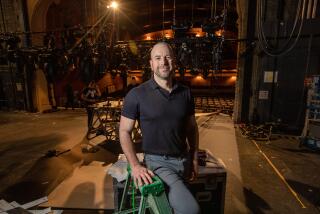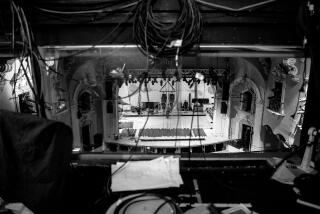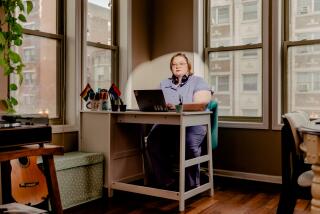Dixie of ‘Tupperware Party’ fame throws a ‘Happy Hour’ to help Segerstrom
- Share via
She’s a fiery redhead with a heart of gold. A sassy Southern gal whose euphemisms would make a sailor blush. She believes that the four food groups are gin, rum, vodka and tequila, and she’d like to invite you to happy hour at her place.
Dixie Longate is the drag persona of actor, writer and comedian Kris Andersson, who has been touring with his solo show, “Dixie’s Tupperware Party,” for longer than a decade. Like most everything else, that run came to a screeching halt last March, and Andersson was left to ask: What now?
His answer: a digital “Dixie’s Happy Hour” featuring a 95-minute performance streamed to patrons of 21 arts centers and theaters across the country. Nine of those organizations are selling tickets, including the Segerstrom Center for the Arts in Costa Mesa, which this week launched a two-week run.
A year into the pandemic, streaming shows are nothing new, but Andersson’s approach of a touring schedule rather than a one-off with a particular theater is novel. As is his profit-sharing model: Hosting theaters keep 80% of their ticket sales, and 20% goes to Andersson for the cost of the production and royalties owed to the crew who filmed the show, which was recorded with an eye toward making it appear live.
The new L.A. Arts Recovery Fund initiated by the J. Paul Getty Trust will support small and medium-sized arts nonprofits.
“I wanted this to be a way for me to give back to theaters,” Andersson said by phone from a long-postponed, admittedly still ill-timed vacation to Puerto Vallarta. “My hope is that if this show sells well, and does well, it will bring some needed revenue to these regional theaters while they remain shut down due to COVID.”
Dixie is a beloved character in many of the markets she’s returning to, including the Denver Center for the Performing Arts, which has the show scheduled for a three-day run in March. Andersson has performed in Denver six times for runs totaling six and a half months. Denver even coproduced a “Tupperware Party” sequel, “Dixie’s Never Wear a Tube Top While Riding a Mechanical Bull (and 16 Other Things I Learned While I Was Drinking Last Thursday).”
“We have a long, rich history with the character of Dixie Longate,” said John Ekeberg, executive director for the center’s Broadway and cabaret divisions. “Denver has developed an audience that always comes back whenever Dixie comes to town.”
In April, Denver was forced to reduce its staffing costs by more than 50% and Ekeberg said furloughs hit the organization hard. That’s why it feels so good to put energy into promoting and selling tickets for a show through the box office, he said, even if it means patrons will enjoy the performance from home.
In a year in which so many theater makers learned to become de facto film and television directors, the quality of streaming theater content has been rising. Performers learned that immediacy and interactivity work wonders for audiences exhausted by the passivity of their Netflix queues. The monologue — delivered directly to the camera — became a hallmark of pandemic-era streaming theater.
Ryan J. Haddad, who has cerebral palsy, turns the answer into theater: ‘Hi, Are You Single,’ streaming through Woolly Mammoth and IAMA theaters.
Andersson found inspiration in the work of the Geffen Playhouse, which staged successful streaming shows through its Stayhouse platform, including magician Helder Guimarães’ interactive spectacles “The Present” and “The Future” and writer Sri Rao’s cook-along memoir “Bollywood Kitchen.”
Unlike the Geffen’s format or illusionist-mentalist Scott Silven’s show presented through the Broad Stage, “Dixie’s Happy Hour” is prerecorded. But Andersson employs multicamera techniques similar to those used in other recent livestreamed productions. He talks directly to the camera, asks questions of the digital audience and allows minor vocal flubs to go unedited. (Although those might just be intentional slurring from all the cocktails Dixie consumes during the in-depth tour of her liquor cabinet.)
Andersson partnered with the company Stream Ally to create a platform where shows can be streamed at the same time through multiple venues in various time zones, maximizing audience and revenue for participating theaters.
Tickets are sold directly through each theater’s box office. Theaters decide how long to run the show, how many performances to host and how many tickets to sell to each performance. Andersson set a universal base price of $35 per screen to prevent theaters from trying to undercut one another, but any given venue can set higher prices for special packages. Even though the recording could theoretically be offered for on-demand consumption, Andersson stipulated that it be made available as appointment viewing — an event that starts at a prescribed time and that unfolds without a pause button — to better replicate the theatergoing experience.
Andersson hopes the platform has legs and that other theater makers might use it to stage virtual shows through theaters around the country. This “Netflix for theater,” as Andersson called it, could ultimately democratize which shows and performers get into major regional theaters and performing arts centers, he said, and make the shows more accessible to audiences who might otherwise not attend in person.
In a typical year, Dixie shows can attract 52,000 to 78,000 patrons. Andersson hopes the digital version will reach that number in just a few months.
“I think this allows us to expand our reach,” Segerstrom President Casey Reitz said of Dixie’s show and the pandemic rise of streaming theater in general. “The idea has been bandied about for years, but we were afraid to pull the trigger because you didn’t want to cannibalize your live audience.”
The pandemic, however, has changed those calculations. Segerstrom ticket sales from April 2019 through February 2020 totaled $18.6 million, Reitz said; with Segerstrom closed by the coronavirus, ticket revenue from April 2020 to present amounts to less than $100,000.
COVID-19 has forced the issue in a compelling way, Reitz said, and it’s interesting to see how the conversation has evolved along with the art. The enhanced quality and immediacy of streaming theater have made it possible to imagine a future where live and digital theater happily coexist.
“It’s just more revenue, and a broader reach for everybody,” said Reitz, who was waiting for updated ticket sales numbers for “Dixie’s Happy Hour” but characterized the show as doing well.
That’s all that Andersson really wants for the show, which he considers his way of paying it forward to the organizations that supported his rise. Like Dixie, who takes great pains to tell her audience that they are special just for being the first ones to make it to their mama’s eggs, Andersson has a soft spot for humanity, no matter how hurt or flawed.
“Never miss the great things right in front of you,” Dixie tells the audience during the show, quoting her mother. “They are always there. You sometimes just need to look a little closer to see them.”
That holds true during a dark but hopeful winter when some closed arts venues are serving as vaccination sites. Until those places go back to being the nerve centers of joy and fulfillment, Longate offers another Dixie-ism: “You can make anything sparkle with just a little bit of effort.”
'Dixie's Happy Hour'
Where: Streaming through Segerstrom Center for the Arts
When: Through Feb. 21
Tickets: $35 per household
Info: scfta.org
Running time: 1 hour, 35 minutes (no intermission)
More to Read
The biggest entertainment stories
Get our big stories about Hollywood, film, television, music, arts, culture and more right in your inbox as soon as they publish.
You may occasionally receive promotional content from the Los Angeles Times.












